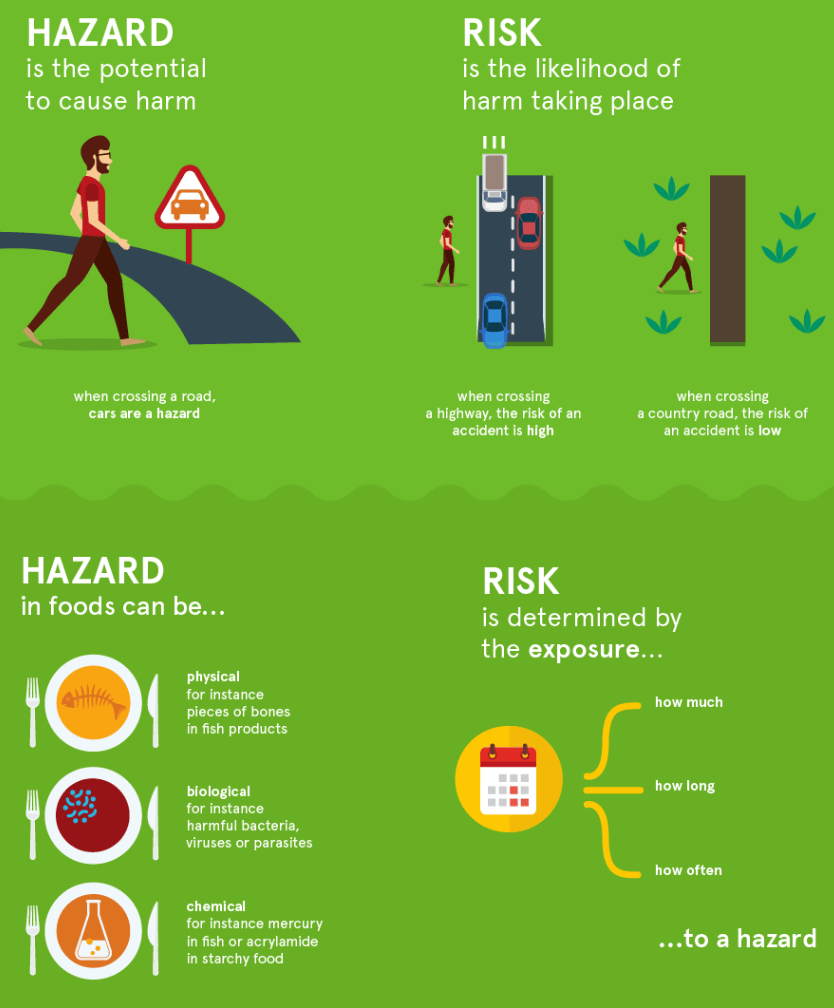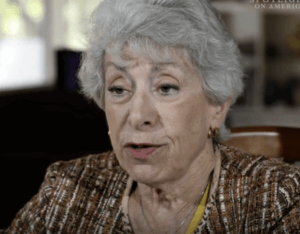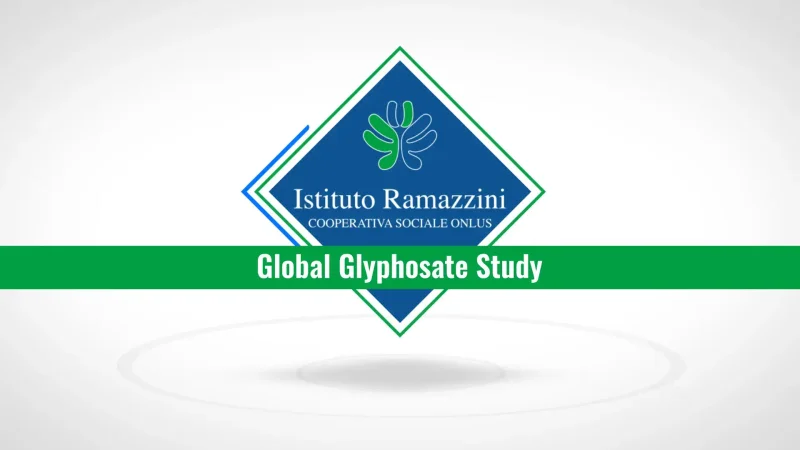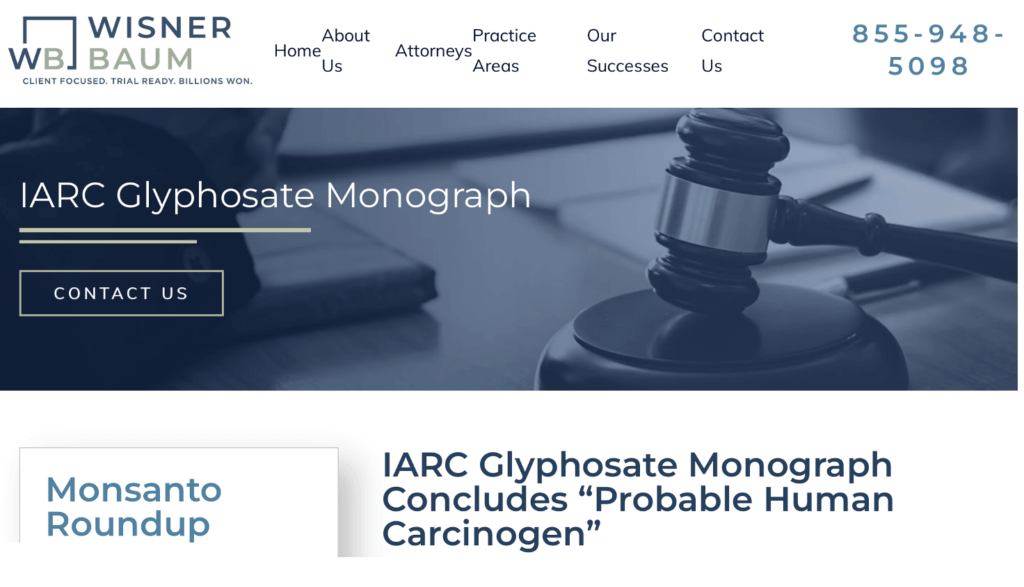- Cell phones and radio frequencies from 5G and other wireless networks
- Sucralose and Aspartame sweeteners
- Glyphosate herbicide
What are the assessments by the world’s most respected regulatory and oversight agencies? None of them believes they cause cancer. (Click on the three categories below to read how representative independent research organizations have assessed these very same chemicals and radio waves.)
- Cell phones and radio frequencies from 5G and other wireless networks: This state-of-the-art study and global regulatory and health agency conclude there is no cancer threat from cell networks.
- Sucralose and Aspartame: According to the National Cancer Institute, currently-approved artificial sweeteners do not cause cancer.
- Glyphosate herbicide: Every prominent global chemical oversight agency in the world — 22 of them — has concluded that the weedkiller is not carcinogenic to humans via either garden use or in trace amounts in our food.
What are the threads that link Ramazzini’s cancer determinations?
- It bases its conclusions on “hazard” cancer studies. Most hazards — like eating red meat or going to the barbershop or drinking wine — are considered hazards but pose no serious risks when experienced in moderation. As an example, dihydrogen monoxide (DHMO) is hazardous as it could result in suffocation, accelerating corrosion, severe burns, erosion of the natural landscape, is a major component of acid rain and contributes to the greenhouse effect. Should it be banned? Let’s hope not. DHMO is the chemical name for water. The point is that most anything can be hazardous. This chart that identifies (on the left) what Ramazzini evaluates versus (on the right) what every regulator and independent agency, such as the EPA, European Food Safety Authority, and Health Canada, do — assess: human risk. A hazard determination does not mean a product is dangerous but journalists — and juries in tort class action suits — often equate the two.

- Ramazzini’s findings are mostly based on unreliable rodent studies rather than real-world tracking of humans. For its experiments, the institute uses what’s known as the Sprague-Dawley rats. This type of rat spontaneously produces cancer even without exposure to a toxin — as much as 80% of the time. For that reason, regulators generally don’t put much weight on cancer research using this type of rat because of false cancer positives.
- Ramazzini’s findings show only associations or what the press often refers to as “links”. Regulators, rather, look to identify causation — a more conclusive standard, as this Harvard Center for Risk Analysis article underscores.
- Its findings are published most often in Environmental Health or Environmental Sciences Europe — lower rung, open source journals that regularly publish articles by scientists known for: (a) their ideological views and links to Ramazzini (e.g., Philip Landrigan and Fiorella Belpoggi; see more on Belpoggi below); (b) scientists who are known ideologues and whose research has been discredited in peer-reviewed journals (e.g., Gilles-Éric Séralini); see more on Séralini below); (c) Ramazzini-affiliated scientists who sell their services to tort lawyers who file class action suits based on Ramazzini’s findings (e.g. Christopher Portier, see more on Portier below). Environmental Health is actually a Ramazzini creation; its senior editors, David Ozonoff and Phillipe Grandjean, deputy editor Ruth Etzel, and associate editor Valentini Forastieri are all Ramazzini Fellows.

Credit: Larry Deal - Ramazzini studies are invariably endorsed by Linda Birnbaum, former director of the National Institute for Environmental Health Sciences. (Here is her endorsement of contested claims about the alleged cancer-causing dangers of radio frequency radiation). Birnbaum is a member of the Collegium Ramazzini; she directed more than $90 million in NIEHS taxpayer funds to her Ramazzini colleagues while at the NIEHS. Birnbaum’s endorsements are used as evidence by tort lawyers in class action suits.
- In many cases, prominent global risk agencies that countries around the world rely upon to assess real-world cancer dangers — examples include the US National Toxicology Program, the European Chemicals Agency, the European Commission, the Food Safety Commission of Japan, the World Health Organization — have reviewed findings by Ramazzini and found them contrary to consensus science.
The findings by globally respected independent agencies contrast sharply with the views of some prominent environmental advocacy groups prone to trumpet studies that align with their ideological opposition to synthetic chemicals. Examples include the Environmental Working Group, Center for the Study of Science in the Public Interest, Natural Resources Defense Council and others considered by many in the media to be independent and fact-based. How do these groups view the Ramazzini Institute? In almost all cases, they publicize Ramazzini hazard assessments while ignoring the consensus global gold standard: risk analysis.
Ramazzini Institute history
Most people, including many scientists, have never heard of the Ramazzini Institute. It is named after Bernardino Ramazzini, a 17th-century Italian physician whose work, De Morbis Artificum Diatriba, earned him the title “father of occupational medicine”. He conducted scientific studies of workers’ conditions in a wide variety of occupations, taking pains to address risk and exposure duration, instead of merely hazards. He did not advocate banning any substances or chemicals directly.
Not so the Institute and Collegium Ramazzini which carries his name and uses his former home as their headquarters. These twin organizations were founded in 1982, by environmental health advocates promoting the precautionary principle, a controversial hazard-based standard used almost exclusively in Europe but rejected by most of the rest of the world.
Collegium Ramazzini and its smaller US-based institute were founded by Cesare Maltoni, who identified the carcinogenic risks of benzene and vinyl chloride; and Irvine Selikoff, known for work on tuberculosis and the dangers of asbestos. The Collegium’s bylaws claim that “Taken as a whole, the purpose is to be that of a bridge between the world of scientific discovery and those social and political centers which must act on these discoveries to conserve life and prevent disease.”
Ramazzini is now becoming known for bridge building, but of a far different kind: It helps link scientists and advocacy groups and class action law firms that target industry, from manufacturers of cell phones and towers to artificial sweeteners to talc powder, to the bugaboo of anti-chemical campaigners, glyphosate.
Ramazzini ‘s focus changed from risk to hazard under the direction of Fiorella Belpoggi, Head of Research and Director of the Cesare Maltoni Cancer Research Centre, which she joined 40 years ago. Instead of using health risks as Bernardino advocated, Ramazzini advocates hazard studies as a basis for banning substances.
Ramazzini—IARC connection
Ramazzini also works closely with a like-minded unofficial partner organization, the International Agency for Research on Cancer. Like Ramazzini, IARC relies mostly but not exclusively on rodent-based hazard studies. That means that it finds virtually every substance that it evaluates potentially cancer-causing (IARC has assessed more than 1,000 substances or situations and found only one was not a likely or possible carcinogen). Among the substances or situations that are “probably carcinogenic” or worse: working the night shift, art glass, eating red meat and drinking hot beverages. These all fall in IARC’s 2A category — along with the herbicide glyphosate.
IARC’s reputation among mainstream scientists is mixed. Many agree its hazard studies serve a useful purpose by identifying products or processes that should be subsequently reviewed by risk assessing agencies. But over the past decade it has reached some bizarre conclusions that have fed public hysteria and provided grist for class action lawyers. For example, IARC lumps together the following substances or processes in what it calls Category 1, “carcinogenic to humans”: eating processed meat, consuming Chinese-style salted fish — and smoking cigarettes and burning coal at home. Category 2A, “probably carcinogenic to humans”, includes the weedkiller glyphosate — and eating red meat, drinking hot beverages, consuming wine or beer, using oral contraceptives, frying foods, going to a barber on hairdresser and working the night shift.
The key problem with IARC’s category classifications on select products or processes results is that it feeds hysteria by the media which cannot distinguish between low level hazards like glyphosate or going to the barber. Even respected journals have fed the disinformation bazaar. It headlined its article: “Widely Used Herbicide Linked to Cancer. Note it used the word “linked” which is misunderstood by the press and capitalized on by ideological groups. After all, drinking wine and going to the hair dresser are also “linked” to cancer.
 Exploiting these confusions, IARC’s monographs are invariably distorted and hyped by anti-chemical advocacy groups — which IARC often coordinates with — and in some cases become grist for class action lawyers. No one is suing companies that make bacon or employ night-shift workers, but its 2A categorization of glyphosate which IARC also concluded has been the single most important factor in the filing of more than 100,000 suits targeting glyphosate manufacturers.
Exploiting these confusions, IARC’s monographs are invariably distorted and hyped by anti-chemical advocacy groups — which IARC often coordinates with — and in some cases become grist for class action lawyers. No one is suing companies that make bacon or employ night-shift workers, but its 2A categorization of glyphosate which IARC also concluded has been the single most important factor in the filing of more than 100,000 suits targeting glyphosate manufacturers.
Note what is left out in news or advocacy groups reports about IARC’s findings:
- “No data on cancer-related susceptibility after exposure to glyphosate were available to the Working Group
- “Limited evidence in humans for the carcinogenicity of humans”
- IARC’s finding that glyphosate is ‘probably carcinogenic’ applies only to glyphosate applicators, not the public.
- There was no evidence that trace amounts of glyphosate in food could cause cancer
In the wake of the IARC designation, the global science consensus firmly remains that glyphosate is a comparatively mild herbicide that poses no safety threat to the general population from residues in our food and that there is no evidence in human studies that it cause cancers in workers who face long term exposure. Considered the most credible human research on glyphosate, the USDA’s Agricultural Health Study that tracked the health of more than 54,000 farmers from 1993 to 2018, found “no association was apparent with glyphosate and an any solid tumors or lymphoid malignancies overall, including non-Hodgkin’s lymphoma ….” IARC pointedly excluded this report from its evaluation.
A year after IARC issued its evaluation, a joint United Nations and World Health Organization panel reviewed the potential for glyphosate in food to cause cancer in people. It concluded the weedkiller was “unlikely to pose a carcinogenic risk to humans.” The US EPA notes on a fact sheet that there is “no evidence that glyphosate causes cancer in humans. It ordered the state of California to remove danger warnings on the product which were instituted in the wake of IARC’s hazard report. Health Canada twice reviewed IARC’s hazard data, concluding: “No pesticide regulatory authority in the world currently considers glyphosate to be a cancer risk to humans at the levels at which humans are currently exposed.”
Ramazzini on ‘cancer causing’ chemicals
The US-based arm of the Ramazzini Institute partners with the IARC monograph program, referring the same chemicals or process to each other, which reinforces their media and regulatory impact and emboldens the predatory industry. Ramazzini has had more than 300 “fellows” in its Collegium (currently there are 180) including Linda Birnbaum; many, like Christopher Portier, end up as paid consultants and expert witnesses for plaintiff suits challenging companies that manufacture alleged carcinogens. In return, many Ramazzini fellows serve on IARC studies as experts. Not surprisingly, Ramazzini’s conclusions invariably echo IARC’s findings; the global risk-based science community and regulators disagree with most of their conclusions.
Most Collegium Ramazzini fellows and leaders are part of a sub-set of epidemiologists who believe synthetic chemicals (as opposed to highly-toxic naturally occurring ones) are the driving cause of cancer and many other diseases — a view not endorsed by the wider science community.
In 2021, 2006, and 2010, Ramazzini Institute concluded that aspartame is a likely carcinogen. Its findings were roundly rejected by the global scientific community. It did not give up. A reanalysis in 2021 “confirmed its conclusions. According to the Institute:
This reanalysis confirmed the original diagnoses of cancer in 72 (92.3%) of 78 cases and determined that another 3 lesions (3.8%) were premalignant. This reanalysis also confirmed the presence of a statistically significant, positive dose-response relationship between aspartame exposure and cancer incidence. Lastly, it reconfirmed that prenatal exposures to aspartame produces a dose-related increase in cancer incidence in offspring at lower exposure levels and with shorter latency than in adults.
Backed by a massive PR campaign, its “new evidence” was ballyhooed by advocacy groups and the media, but it mostly restated its earlier discredited conclusions. It’s notable that “rodent” and “hazard” and “association” and “link” were not used in the news release touting its findings. While Ramazzini’s studies are embraced by IARC and often publicized by the media globally, they are not accepted for review by the US Environmental Protection Agency and other global regulatory authorities.
Most damning is Ramazzini’s almost exclusive use of Sprague-Dawley rats. They were used in the Séralini GMO corn and glyphosate study retracted in 2013. As Scientific American reported, independent scientists concluded:
[T]he small number and type of animals used in the study mean that “no definitive conclusions can be reached.” The known high incidence of tumors in the Sprague–Dawley strain of rat “cannot be excluded as the cause of the higher mortality and incidence observed in the treated groups.”
Ramazzini’s scientific director Belpoggi has published numerous studies using Sprague-Dawley rats, most recently in 2021, in which a who’s who of advocacy scientists claimed glyphosate could dangerously impact gut health. Another major question mark about the study: no other research has shown evidence that the weedkiller causes intestinal disorders.
Belpoggi appears to have an obsession with glyphosate, which is sometimes paired with genetically modified crops. In 2014, she was one of only three members of an oversight board for a Russian-based initiative called Factor GMO. The organization claimed it would be conducting the world’s largest, most transparent study into the alleged cancer-causing properties of GMOs and glyphosate. No report was ever issued. The campaign was later exposed as a Kremlin disinformation operation that never performed any research.
Both Ramazzini and IARC have focused extensively on glyphosate. IARC’s review board of the herbicide in 2014-2015 included numerous Ramazzini fellows, including Christopher Portier. Portier, currently a Ramazzini fellow was the key lobbyist urging IARC to review glyphosate. It’s also believed he was responsible for the last-minute defenestration of the almost-final monograph, which according to a Reuters investigation had concluded that the herbicide was not carcinogenic. Within days of IARCs release of Monograph 112 in 2015 declaring glyphosate a “probable carcinogen” (again, based on hazard and not risk/exposure).
Predatort racket
While government agencies such as the US EPA and European Food Safety Agency (EFSA) do not use Ramazzini and IARC hazard reports in their assessments of environmental and health risks, they are often the only evidence marshaled by law firms who prey for clients to sue chemical makers. A recent Ramazzini hazard study set off a feeding frenzy among the predators.
 Many of these firms are behind the recent large class action suits against companies manufacturing glyphosate, talcum powder and other chemicals that hazard studies but not risk-based studies deem as dangerous. Most aggressive is the Church of Scientology Law firm Wisner Baum, renamed from Baum Hedland earlier this year. They are known in the industry as “ambulance chasers” (their motto: “Client focused. Trial Ready. Billions Won”).
Many of these firms are behind the recent large class action suits against companies manufacturing glyphosate, talcum powder and other chemicals that hazard studies but not risk-based studies deem as dangerous. Most aggressive is the Church of Scientology Law firm Wisner Baum, renamed from Baum Hedland earlier this year. They are known in the industry as “ambulance chasers” (their motto: “Client focused. Trial Ready. Billions Won”).
Baum Headline helped rescue the Church from near bankruptcy in the 1990s by suing the makers of Prozac and other anti-depressants claiming the drugs were more harmful than helpful. Scientists considered the suits frivolous, but fearing bankrupting court judgments, the manufacturers paid out billions of dollars to settle the cases. I talked with former employees at the firm who said the lawyers, all Church members, viewed the glyphosate case as ‘another Prozac”. Within hours after the release of the 2015 IARC monograph, they posted this on their website.
The Church of Scientology law firm went on to partner with Robert F Kennedy, Jr. to successfully sue Bayer/Monsanto over alleged damages from glyphosate. The plaintiffs won the first three cases against Bayer but have lost the last seven. Firms regularly hire Ramazzini fellows to act as expert witnesses, conduct depositions and write briefs. Ramazzini fellow Christopher Portier was hired by the Church’s law firm to serve as a key plaintiff witness in almost all of the suits. These gigs are quite lucrative. He was paid $450 an hour to advise on glyphosate lawsuits and testify in court, rolling up hundreds of thousands of dollars in fees. Here is testimony in one case posted by Wisner Baum on YouTube:
Follow the money
The relationship between law firms, Ramazzini, IARC, and expert witnesses has led to a huge jump in the number of class action lawsuits, from 75 in 2015 to more than 300. The number of class action plaintiffs has increased from a few hundred for each case to tens of thousands of people.
Plaintiffs don’t get the biggest rewards in these cases. One big winner are the ‘expert’ witnesses, who in these cases are or were affiliated with IARC or Ramazzini. In an excellent story published earlier this week on the tort racket, journalist and professor David Zaruk refers to Ramazzini as:
… a type of Rotary Club for activist scientists, mostly retired American regulatory scientists who use their peer-approved fellowships in this exclusive/seclusive network to arrange lucrative consultancy projects, places on IARC monograph panels and the subsequent US Predatort litigation consulting honey-pots. Many Ramazzini members have made millions using this network to become expert advisors in tort lawsuits for plaintiffs claiming damages, often based solely on IARC monographs.
There’s a lot of money for scientists willing to go on the road to tout Ramazzini’s and IARC’s hazard conclusions. But the golden ring of litigation goes to a somewhat new type of private finance investor who spends billions of dollars on what’s called litigation finance. These companies or investment consortiums provide law firms upfront money to organize and market class action lawsuits in hopes of taking the largest slice of the billion-dollar settlement pie. Investors in these companies usually get returns of 25-35 percent.
In 2019, according to Swiss Re, a reinsurance firm, private equity funding of mass torts (lawsuits) reached $17 billion. A 2022 60 Minutes Lesley Stahl episode called this funding “a new multibillion-dollar industry, where investors fund lawsuits…betting on the lawsuit the way that traders bet on stocks.” It’s also not regulated.
Where else does the money from billion-dollar settlements go? Recipients include university faculty whose research is funded by litigation finance investors (but almost never disclosed) who then show up as expert witnesses. Perhaps the biggest windfall goes to advocacy environmental groups known for their alarmism such as Environmental Working Group, US Right to Know, NRDC and other NGOs that loudly proclaim their independence and target scientists as corporate lackeys. Almost all of these donations are given to advocacy group foundations, which allows them to hide this arrangement from the media and public.
These “predatort” lawsuits not only wreak havoc on the legal system, they undermine the concept of fact-based justice. Philip Goldberg, office managing partner of Shook Hardy and Bacon in Washington, D.C., wrote recently:
Courts have found the overwhelming number of these claims are meritless. They are manufactured to feed a business model that takes advantage of imbalance, inefficiencies, and transaction costs of the civil justice system. Claims are produced by lead generator(s) and filed by lawyers, often without vetting…but there is no way for the courts to try all cases. For many companies, the only way out is to settle en masse–even when claims have no factual or legal basis…the lawyers were banking that the claims would be swept into a global settlement.
Not exactly the science-based principles that the original Ramazzini Institute was founded to uphold.



































